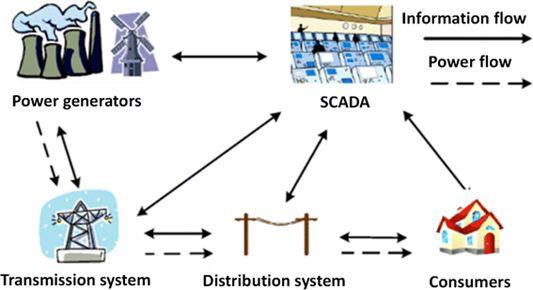Introduction
SCADA stands for Supervisory Control and Data Acquisition. It is a system of hardware and software elements which allows organizations and industries to control and operate processes remotely, gather data, and monitor real-time information. SCADA systems are commonly used in industries such as power generation and distribution, water and wastewater treatment, oil and gas refining, manufacturing, transportation, and more.

(P.C-dpstele.com)
Key components of a SCADA system
- Supervisory Control: SCADA systems provide a centralized interface for plant operators to monitor and control industrial processes like they can switch on/off systems by giving command on the PC remotely. This interface typically includes graphical representations of equipment, processes, and data, allowing operators to visualize operations and make informed decisions.
- Data Acquisition: SCADA systems collect data from various sensors, meters, and other devices located throughout the industrial facility. This data can include parameters such as temperature, pressure, flow rate, voltage,current and more.Local disk management system can store the historical data for analysis.
- Remote Terminal Units (RTUs) or Programmable Logic Controllers (PLCs): RTUs or PLCs are deployed in the field to interface with sensors and equipment, gather data, and execute control commands. They communicate with the central SCADA system to transmit data and receive instructions. Using this a plant can be operated by sitting miles away from it.
- Communication Infrastructure: SCADA systems rely on communication networks to transmit data between field devices and the central control center. These networks can include wired connections such as Ethernet or serial communication, as well as wireless technologies like radio, cellular, or satellite communication.
- Human-Machine Interface (HMI): The HMI is the user interface of the SCADA system, providing operators with tools to interact with the system, view data, and control processes. HMIs typically include features such as alarms, trend displays, historical data analysis, and reporting capabilities.Plant specific software can be modeled and installed in the system for use of operators.
- Historian: SCADA systems often include a historian component to archive and store historical data collected from industrial processes. This data can be used for analysis, reporting, and optimization purposes.
- Security Features: As SCADA systems are critical infrastructure components, they incorporate various security measures to protect against cyber threats and unauthorized access.As communication networks are used for command and monitoring of plants they can be hacked ,therefore the measures can include user authentication, encryption, firewalls, and intrusion detection systems.
In 2021 hackers caused power blackout in Mumbai, India , you may read about it here.
SCADA (Supervisory Control and Data Acquisition) systems offer numerous advantages, primarily in optimizing production processes and ensuring regulatory compliance within industries. They serve as invaluable tools for troubleshooting, playing a significant role in maintaining uninterrupted production flows with minimal errors.
SCADA in Smart Grids
Smart grids are complex and dynamic systems that require real-time data and communication between different components and actors, such as generators, distributors, consumers, and regulators. SCADA can provide the backbone for the data acquisition, processing, and transmission of smart grids, as well as the control and automation of the energy management and distribution. SCADA can help smart grids achieve goals such as load balancing, demand response, peak shaving, voltage regulation, outage management, and integration of distributed and renewable energy sources
SCADA systems play a crucial role in modern smart grids by providing real-time monitoring, control, and automation capabilities. In the context of smart grids, SCADA systems help utilities efficiently manage and optimize the generation, distribution, and consumption of electricity.

Here’s how SCADA is integrated into smart grid systems:
- Real-time Monitoring: SCADA systems continuously collect data from various devices such as sensors, meters, switches, and relays deployed throughout the grid infrastructure. This data includes voltage levels, current flows, power quality, equipment statuses, and environmental conditions. Real-time monitoring allows operators to have a comprehensive view of the grid’s operational state.
- Control and Automation: SCADA systems enable operators to remotely control devices and equipment within the grid infrastructure. This includes actions such as opening or closing circuit breakers, adjusting voltage levels, and re-routing power flows. Automation features allow for the implementation of predefined logic and algorithms to respond to events or changing conditions without manual intervention.
- Fault Detection and Management: SCADA systems help detect and locate faults or abnormalities within the grid, such as equipment failures, line outages, or voltage disturbances. Rapid identification of these issues enables operators to take appropriate actions to minimize disruptions and restore service quickly.
- Optimization and Energy Management: By analyzing real-time and historical data, SCADA systems facilitate the optimization of grid operations, including load balancing, voltage regulation, and renewable energy integration. Advanced algorithms can be employed to optimize energy flows, reduce losses, and enhance overall system efficiency.
- Cybersecurity: As smart grids rely heavily on digital communication and automation technologies, cybersecurity is a paramount concern. SCADA systems incorporate robust security measures to protect against cyber threats, including encryption, authentication, access control, and intrusion detection mechanisms.
- Integration with other Systems: SCADA systems are often integrated with other enterprise systems such as Energy Management Systems (EMS), Distribution Management Systems (DMS), and Outage Management Systems (OMS). This integration enables coordinated decision-making and facilitates efficient operation across different domains of the grid.
Real example : A 220/132kv Grid Substation can be remotely operated by sitting miles away from it. Circuit breakers can be turned on or off ,Isolators and earth switch can be opened. If any feeder draws more power than allotted to it then it can read the data and take necessary action on it. This system can minimize no.of operators required to run a plant.
As industrial operations expanded and became more remote, the imperative for automated solutions became evident. With increasingly automated and semi-automated processes, businesses can reallocate resources efficiently, resulting in long-term cost savings.
Overall, SCADA systems play a crucial role in modern industrial automation by providing real-time visibility, control, and optimization of complex processes, leading to improved efficiency, safety, and reliability.